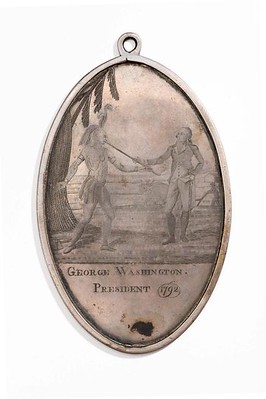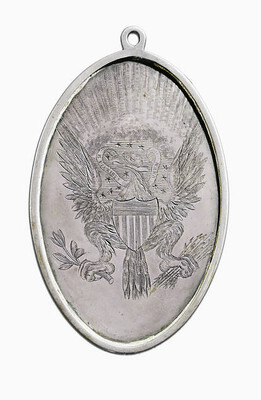
PREV ARTICLE
NEXT ARTICLE
FULL ISSUE
PREV FULL ISSUE
COLONIAL WILLIAMSBURG ACQUIRES PEACE MEDALColonial Williamsburg announced its acquisition of a small size 1792 George Washington Indian Peace Medal. Congratulations! -Editor
When George Washington was inaugurated as the first President of the United Sates 232 years ago in April 1789, the nation's leaders were well aware that Crafted in Philadelphia, Pennsylvania, of silver by an unidentified silversmith, this Washington Indian peace medal is 5-1/4 tall by 3-3/16 wide and weighs 76.15 grams. The medal is now on view in the Backcountry section of A Rich and Varied Culture: The Material World of the American South, a long-term exhibition at the DeWitt Wallace Decorative Arts Museum, one of the newly expanded Art Museums of Colonial Williamsburg.
The custom of giving peace medals has a long history in America. By the French and Indian War, Anglo-Americans began producing impressive medals in hopes of competing against varied European interests for the allegiance of diverse Native American groups. These include medals commissioned by the Quakers struck in Philadelphia for the 1757 Treaty of Easton and Virginia's The newly formed War Department staff, responsible for overseeing Indian affairs, found it challenging to procure these indispensable silver medals. Without the necessary minting machinery, each had to be handmade and painstakingly engraved by expert craftsmen in order to convey the importance embodied in these large, high-quality medals. The work was time consuming and expensive, but the United States government considered it worth the price as they were enthusiastically appreciated by the recipients. In 1792, a spectacular design was created that began the custom of featuring a prominent image of the sitting president on the front of the medal. This tradition continued for nearly a century until the Indian peace medal program ended in 1891. The new design, which was very large and oval, presented a view of George Washington helping to support a pipe being smoked by a traditionally dressed American Indian warrior. On equal footings, the president appears in his military uniform while his ally wears armbands, a feathered headdress and a large oval medal around his neck. Behind the warrior rests his tomahawk placed on the ground. This peace ceremony is depicted at the edge of a wood with the warrior below the branches of a tree and Washington before an agricultural scene. Below is the legend GEORGE WASHINGTON, PRESIDENT 1792. The reverse side features an engraving of the Great Seal of the United States.
Production of the large format oval medals ended in 1795, likely because of the expense and difficulty of having them hand-made, perhaps compounded by an increasing need for them. Today, the engraved Indian peace medals of George Washington's presidency remain at the pinnacle of early American numismatic and historical treasures. This acquisition was made possible through Colonial Williamsburg's Lasser Numismatics Fund.
To read the complete article, see:
To read an earlier E-Sylum article, see:
Wayne Homren, Editor The Numismatic Bibliomania Society is a non-profit organization promoting numismatic literature. See our web site at coinbooks.org. To submit items for publication in The E-Sylum, write to the Editor at this address: whomren@gmail.com To subscribe go to: https://my.binhost.com/lists/listinfo/esylum All Rights Reserved. NBS Home Page Contact the NBS webmaster 
|


